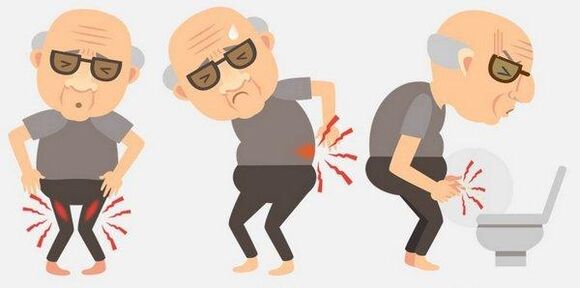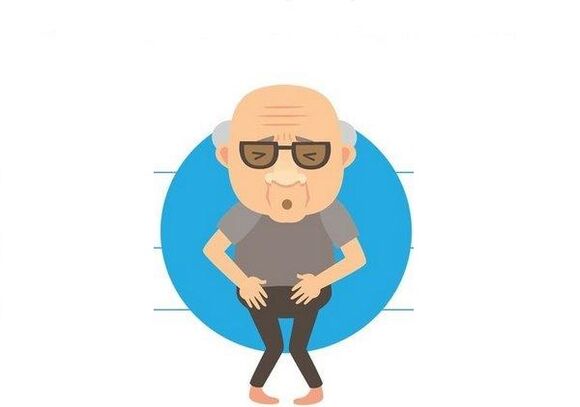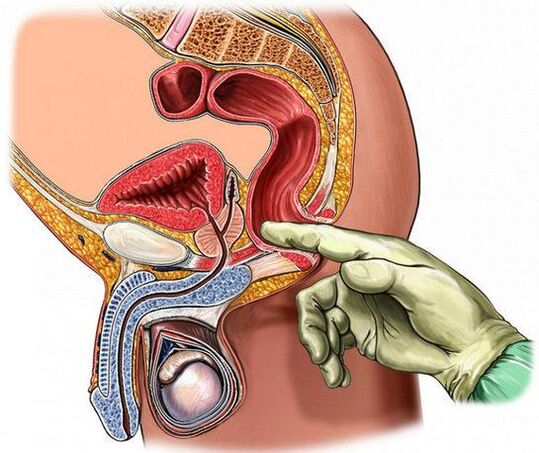The symptoms of prostatitis depend on the shape and causes of the inflammation of the prostate gland, as well as the presence of concomitant diseases. Symptoms often intersect, which significantly complicates diagnosis.

Chronic prostatitis
Chronic prostatitis develops as an independent disease or as a complication of the acute form of inflammation. During remission, the symptoms are weak or completely absent, with exacerbation they become more pronounced. The clinical picture recalls acute prostatitis.
The first symptoms of the chronic form of inflammation:
- Frequent impulse to urination;
- Stupid pains in the lower abdomen;
- Discomfort in the prostate area (area from testicles to anus) with a long living room in sitting position. Subsequently, sitting for more than an hour is impossible due to combustion;
- Intermittent and painful urination;
- Opaque pain in the rectum during defecation;
- The deterioration of an erection, the inconvenience to the groin during ejaculation is possible.
The above signs in the chronic form of prostatitis do not occur simultaneously. Initially, this can be a lubricated orgasm, premature ejaculation, therefore a man must filter during urination, pain gradually unites.
On an ultrasound with chronic inflammation, a decrease in the density of the fabric of the prostate is observed, an increase in the degree of reflection of the wave of tissue. In places, it decreases in the presence of cysts or intensifies in places of exposure to calculations (stones), outbreaks of sclerosis (sealing with connective tissue, formed due to recovery processes after acute inflammation). In the late phases of the outbreaks of connective tissue and fibrosis, there are more and more. The size of the prostate gland is reduced. During visual diagnosis, it is already difficult to distinguish it from the surrounding fiber.
Acute prostatitis
The acute form of infectious prostatitis (bacterial) is characterized by rapid development. The severity of the symptoms depends on the degree of damage to the gland. With a catarrhal form (inflammation affects only the ducts), a man can feel only a slight discomfort during the stress of the inguinal region. During an iron iron exam, it slightly increased and almost painless.
Follicular (purulent inflammation of individual lobers of the gland), parenchymal shapes (inflammatory injury of all prostate tissues) and abscess (capsules with purulent content are formed) are manifested by a complex of whole symptoms:

- Strong pain in groin shot, giving the rectum, testicles, sacred, on the internal sides of the sides, in the penis.
- Fever, general weakness. The active development of pathogens causes body intoxication with inflammatory products.
- Responsible when urine, a feeling of incomplete emptying of the bladder (due to the irritation of the sfinter and the urethral mucosa).
- Purulent discharge from the urethra (the pus comes out of the prostate ducts, opening in the urethra).
- Feeling of gravity in the perineum.
- Quick heartbeat attacks.
- Urine worm with purulent threads. Blood may appear.
With a parenchymal form of prostatitis, painful cramps and pulsating pain in the rectum make it difficult to defecate. Small relief occurs only in a pose that lies with your legs pressed. Often the inflammation of the prostate extends to the rectum, then the mucus begins to be extracted from the anus. The urination against the background of a parenchymal form can be completely stopped due to the serious edema of the gland.
External signs of acute prostatitis on ultrasound:
- Expansion of venous plexuses. The vascular model is more clearly expressed;
- Expansion of the ducts and the capsule of the gland (swelling, irregular increase, stabbing of the contours);
- Increase in the degree of reflection of the wave with fabric;
- The seed bubbles on the sides of the prostate are asymmetrical due to the heterogeneous filling, the ducts that remove the seed are expanded.
With suspicious neoplasms, magnetic resonance imaging is prescribed.
Stagnant prostatitis
The stagnation of prostatitis (it is also called bacterial in the absence of infections) can develop in men of young and older age. The main symptoms are similar to chronic infectious inflammation. A distinctive feature is that the discomfort of the urinary system occurs and improved mainly due to long -term sexual abstinence. An exacerbation can cause violent extension of sexual intercourse, a non -core orgasm (sex without a correct emotional color). The very painful (vagabond) urination is generally observed in the morning. However, if the day before was a complete orgasm, there are no cramps.
With this type, prostatitis is the amount of leukocytes in the secret of the gland does not exceed the norm, there is no pathogenic flora in the third portion of urine.
Prostatitis calculating
Calcular prostatitis has no specific symptoms. The very presence of stones (calculates) in the gland does not mean the automatic development of its inflammation. With physical effort, background pains can intensify. The migration of the stones through the ducts sometimes causes the appearance of blood in the urine.
During an ultrasound of the prostate, calculations are detected. Due to the increase in density, they reflect the waves emitted by the device more effectively.
Characteristics of the manifestation of prostatitis at a young and mature age

The symptoms of various forms of prostatitis do not depend on the age category of a man. Young people actively live sexual life, therefore they develop more often an acute form of infectious inflammation with the corresponding pronounced signs.
Chronic prostatitis is diagnosed in men a few years after the start of sexual activity. During this period, due to the activity of hidden infections, the prostate structure is violated, its cell immunity is reduced. Symptoms appear at a time when pathological changes are already irreversible.
Maturi men mainly suffer from urination disorders, stupid periodic pain in perineum and erection disorders. The licking prostatitis at this age is aggravated by the stagnant processes in the basin against the background of androgenic insufficiency and the loss of muscle tone.
When and to whom to contact
One of the above symptoms is the reason to contact the urologist or in the andrologist (diagnosis of prostatitis in clinical and home conditions). Many men avoid going to the doctor due to a negative attitude towards the examination of the prostate with a finger through the anus or trusts (transrett ultrasound). If the patient categorically refuses these types of studies, the doctor will offer transdominal ultrasounds - when the sensor relies on the lower abdomen. The bladder must be filled (just drink 350 ml of liquid an hour before the procedure).
Based on the results of the ultrasound, the doctor determines the nature of the injury of the prostate fabrics surrounding his tissues and the bladder. To identify the cause of inflammation, it is necessary to pass urine, blood, prostate secret (a rectal gland massage is necessary), in some cases and a spermogram.
Which diseases have similar symptoms
Many diseases have symptoms similar to prostatitis. First of all, it is cystitis (inflammation of the bladder). It is characterized by frequent impulses in the cabinet, spread in the lower abdomen, pain during urination, muddy urine, sometimes with blood. Perhaps a slight increase in temperature.
In men over the age of 45, with symptoms of prostatitis, the gland and gland cancer are mainly excluded. Inflammation against the background of these pathologies is often a secondary sign. The symptoms of gland cancer are similar to the manifestations of a chronic form of prostatitis: periodic urination disorders that attract groin pain. The prostate is painless with a study on the finger, but in its structure there are dense knots.
The distant night urination, a slow flow of urine, a feeling of incomplete emptying of the bubble, loss of drops from the urethra and heaviness in the perineum are characteristics of the adenoma. The image is clarified by palpation and ultrasound: the outlines of the prostate are preserved, the consistency is elastic, the surface is smooth, the iron is almost painless.
Urinary disorders and groin pain can occur with non -infected stones of the prostate - there are calculations, but there is no favorable environment around them to combine pathogens. The discomfort in the perineum in this case causes physical activity, ejaculation. With the feeling of a prostate under your fingers, you can feel the creation (crew of stones), the body of the gland is dense, tuberous, moderately painful.
The urination disorders, characteristic of the chronic phase of the disease, are also characteristic of the sclerosis of the sphincter of the bladder (an obstacle through the urethra in the form of protruding the cut muscle). The pathology is often the result of the prolonged prostate. In men under the age of 40, it is rarely diagnosed.
For chronic prostatitis, expanded venous nodes are often taken (internal hemorrhoids). They can only be found using a special diagnostic tool. Symptoms:
- Pain in the anus, giving the sacred and horse;
- Erection violations;
- Strengthen pain in the rectum and perineum during defecation or prolonged research in sitting position.
The contours and the coherence of the prostate are unchanged. In its secret, pathological changes are absent.

The pain in the anneous area occurs with the proxy - inflammation of the rectum. A characteristic feature is a strong burning sensation in the anus during and after defecation, giving the penis and horse. There are frequent urination pulses (every 20-30 minutes) followed by Lacus urine. Prizatitis often develops simultaneously with prostatitis. In this case, parallel therapy is needed for both diseases.
The symptoms of prostatitis also manifest themselves with the tuberculosis of the gland. In the risk area of a man aged 20 to 40. In the initial stages of development, the disease is almost asymptomatic. Occasionally small pains occur in the rectum and perineum. The violations of urination begin against the background of the involvement in the pathological process of the parts of the gland, communicating the channel that emit urine.
With tuberculosis, purulent cavities are formed in the body of the prostate. When they break through, the content flows into the urethra and is released by the penis during defecation. The bacteria that have fallen into the ureter irritating the mucous membrane, cause quick and painful urination. Through fiber, pus can spread to the rectum. In this case, there is an increase in temperature, weakness, sweating, weight loss.
Conclusion
The prostate gland through the nervous plexus is closely associated with other pelvic organs, whose inflammation provides symptoms similar to prostatitis. The doctor must differentiate (distinguish) prostatitis from other diseases and identify related ones. The patient should not surprise the fact that with the symptoms of prostatitis, the exam is targeted not only to iron, but also to other organs, in particular, to the rectum. It is important to exclude their participation in the formation of pain and urination disorders, otherwise the treatment will be ineffective.
























